What Activity Tansfers Chemical Energy From Algae To Marine Animals
What are Phytoplankton?
July thirteen, 2010
Derived from the Greek words phyto (plant) and plankton (made to wander or drift), phytoplankton are microscopic organisms that live in watery environments, both salty and fresh.
Some phytoplankton are leaner, some are protists, and nigh are unmarried-celled plants. Amongst the mutual kinds are cyanobacteria, silica-encased diatoms, dinoflagellates, light-green algae, and chalk-coated coccolithophores.

Phytoplankton are extremely various, varying from photosynthesizing bacteria (cyanobacteria), to constitute-similar diatoms, to armor-plated coccolithophores (drawings not to scale). (Collage adapted from drawings and micrographs by Sally Bensusen, NASA EOS Projection Science Office.)
Like land plants, phytoplankton accept chlorophyll to capture sunlight, and they use photosynthesis to turn information technology into chemic free energy. They consume carbon dioxide, and release oxygen. All phytoplankton photosynthesize, but some go additional free energy by consuming other organisms.
Phytoplankton growth depends on the availability of carbon dioxide, sunlight, and nutrients. Phytoplankton, like land plants, require nutrients such as nitrate, phosphate, silicate, and calcium at diverse levels depending on the species. Some phytoplankton can gear up nitrogen and can grow in areas where nitrate concentrations are low. They as well require trace amounts of iron which limits phytoplankton growth in large areas of the body of water because iron concentrations are very low. Other factors influence phytoplankton growth rates, including h2o temperature and salinity, water depth, wind, and what kinds of predators are grazing on them.
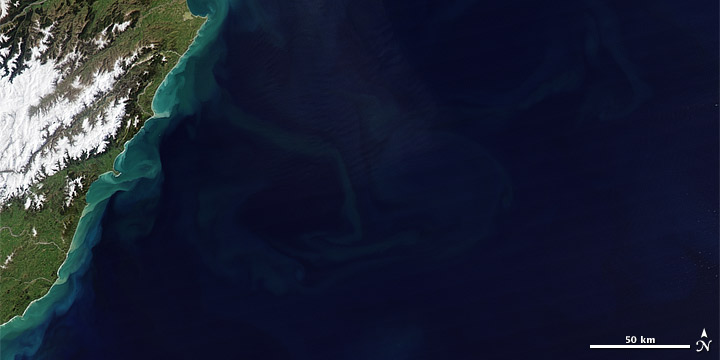
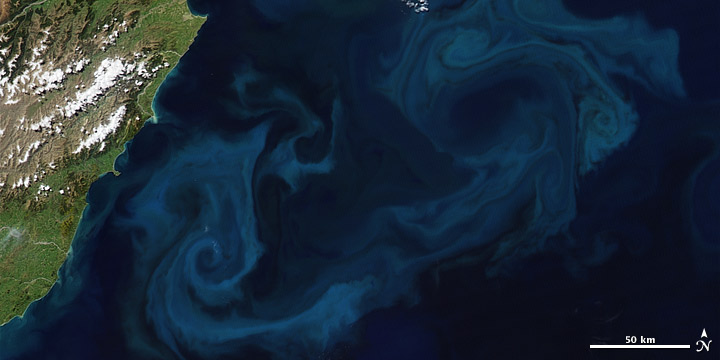
Phytoplankton can grow explosively over a few days or weeks. This pair of satellite images shows a bloom that formed east of New Zealand between October 11 and Oct 25, 2009. (NASA images by Robert Simmon and Jesse Allen, based on MODIS information.)
When conditions are right, phytoplankton populations can grow explosively, a phenomenon known every bit a bloom. Blooms in the ocean may cover hundreds of square kilometers and are easily visible in satellite images. A flower may final several weeks, but the life span of any private phytoplankton is rarely more than a few days.
Importance of phytoplankton
The food web
Phytoplankton are the foundation of the aquatic food web, the primary producers, feeding everything from microscopic, animal-like zooplankton to multi-ton whales. Small-scale fish and invertebrates likewise graze on the plant-like organisms, then those smaller animals are eaten past bigger ones.
Phytoplankton can as well exist the harbingers of expiry or disease. Certain species of phytoplankton produce powerful biotoxins, making them responsible for then-called "cerise tides," or harmful algal blooms. These toxic blooms tin can kill marine life and people who eat contaminated seafood.
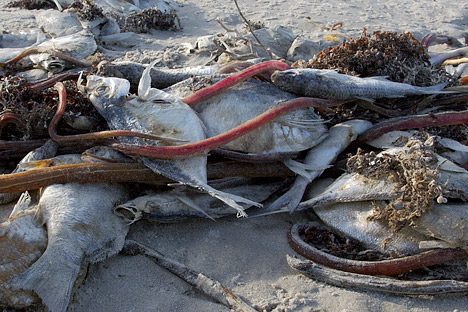
Dead fish done onto a embankment at Padre Island, Texas, in October 2009, following a red tide (harmful algal bloom). (Photo ©2009 qnr-away for a while.)
Phytoplankton crusade mass bloodshed in other ways. In the aftermath of a massive bloom, expressionless phytoplankton sink to the ocean or lake floor. The leaner that decompose the phytoplankton deplete the oxygen in the water, suffocating animal life; the result is a dead zone.
Climate and the Carbon Cycle
Through photosynthesis, phytoplankton consume carbon dioxide on a scale equivalent to forests and other land plants. Some of this carbon is carried to the deep ocean when phytoplankton dice, and some is transferred to different layers of the ocean equally phytoplankton are eaten by other creatures, which themselves reproduce, generate waste product, and die.
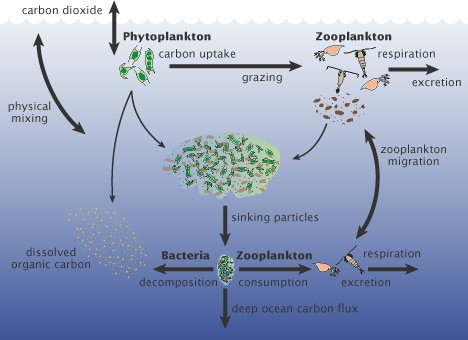
Phytoplankton are responsible for well-nigh of the transfer of carbon dioxide from the atmosphere to the ocean. Carbon dioxide is consumed during photosynthesis, and the carbon is incorporated in the phytoplankton, just as carbon is stored in the forest and leaves of a tree. Virtually of the carbon is returned to near-surface waters when phytoplankton are eaten or decompose, but some falls into the body of water depths. (Illustration adapted from A New Wave of Ocean Science, U.Due south. JGOFS.)
Worldwide, this "biological carbon pump" transfers about 10 gigatonnes of carbon from the atmosphere to the deep sea each year. Even small changes in the growth of phytoplankton may affect atmospheric carbon dioxide concentrations, which would feed dorsum to global surface temperatures.
The Aquatic Food Web

Studying phytoplankton
Phytoplankton samples can exist taken straight from the water at permanent observation stations or from ships. Sampling devices include hoses and flasks to collect h2o samples, and sometimes, plankton are collected on filters dragged through the water backside a ship.

Marine biologists employ plankton nets to sample phytoplankton direct from the body of water. (Photograph ©2007 Ben Pittenger.)
Samples may be sealed and put on ice and transported for laboratory assay, where researchers may be able to identify the phytoplankton collected downwardly to the genus or fifty-fifty species level through microscopic investigation or genetic analysis.
Although samples taken from the ocean are necessary for some studies, satellites are pivotal for global-calibration studies of phytoplankton and their role in climate alter. Private phytoplankton are tiny, merely when they flower by the billions, the high concentrations of chlorophyll and other light-catching pigments change the way the surface reflects light.
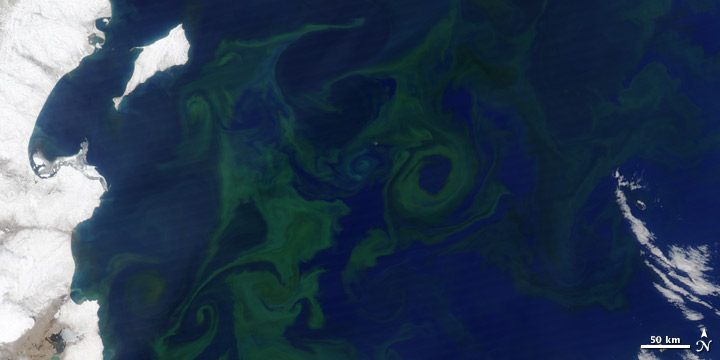

![]()
In natural-color satellite images (top), phytoplankton appear every bit colorful swirls. Scientists utilize these observations to guess chlorophyll concentration (bottom) in the water. These images show a bloom almost Kamchatka on June 2, 2010. (Images past Robert Simmon and Jesse Allen, based on MODIS data.)
The water may turn greenish, carmine, or brownish. The chalky scales that cover coccolithophores colour the water milky white or bright blue. Scientists utilize these changes in ocean colour to estimate chlorophyll concentration and the biomass of phytoplankton in the sea.
Global Patterns and Cycles
Differences from place to place
Phytoplankton thrive forth coastlines and continental shelves, along the equator in the Pacific and Atlantic Oceans, and in high-latitude areas. Winds play a strong role in the distribution of phytoplankton because they drive currents that crusade deep water, loaded with nutrients, to be pulled up to the surface.
These upwelling zones, including one along the equator maintained by the convergence of the easterly trade winds, and others along the western coasts of several continents, are among the nearly productive body of water ecosystems. By contrast, phytoplankton are deficient in remote ocean gyres due to nutrient limitations.

![]()
Phytoplankton are near abundant (xanthous, high chlorophyll) in high latitudes and in upwelling zones along the equator and near coastlines. They are deficient in remote oceans (dark bluish), where nutrient levels are depression. This map shows the boilerplate chlorophyll concentration in the global oceans from July 2002–May 2010. View animation: minor (5 MB) large (xviii MB). (NASA paradigm past Jesse Allen & Robert Simmon, based on MODIS data from the GSFC Ocean Color team.)
Differences from season to flavor
Like plants on state, phytoplankton growth varies seasonally. In high latitudes, blooms acme in the bound and summer, when sunlight increases and the relentless mixing of the water past winter storms subsides. Recent enquiry suggests the vigorous winter mixing sets the phase for explosive jump growth by bringing nutrients upward from deeper waters into the sunlit layers at the surface and separating phytoplankton from their zooplankton predators.
In the subtropical oceans, by contrast, phytoplankton populations drop off in summer. Every bit surface waters warm up through the summer, they become very buoyant. With warm, buoyant water on top and cold, dense water below, the water column doesn't mix easily. Phytoplankton use up the nutrients bachelor, and growth falls off until winter storms kick-outset mixing.
In lower-latitude areas, including the Arabian Sea and the waters around Indonesia, seasonal blooms are often linked to monsoon-related changes in winds. As the winds contrary direction (offshore versus onshore), they alternately heighten or suppress upwelling, which changes nutrient concentrations. In the equatorial upwelling zone, there is very little seasonal modify in phytoplankton productivity.

![]()
In leap and summer, phytoplankton bloom at high latitudes and reject in subtropical latitudes. These maps show average chlorophyll concentration in May 2003–2010 (left) and November 2002–2009 (right) in the Pacific Bounding main. (NASA images by Jesse Allen & Robert Simmon, based on MODIS information from the GSFC Ocean Color squad.)
Differences from year to yr
The biggest influence on year-to-yr differences in global phytoplankton productivity is the El Niño-Southern Oscillation (ENSO) climate blueprint. ENSO cycles are significant changes from typical bounding main surface temperatures, current of air patterns, and rainfall in the Pacific Sea along the equator.
During EL Niño events, phytoplankton productivity in the equatorial Pacific declines dramatically equally the easterly trade winds that ordinarily drive upwelling grow still or even opposite direction. The transition between El Niño and its analogue, La Niña, is sometimes accompanied by a dramatic surge in phytoplankton productivity equally upwelling of nutrient-rich deep water is of a sudden renewed.
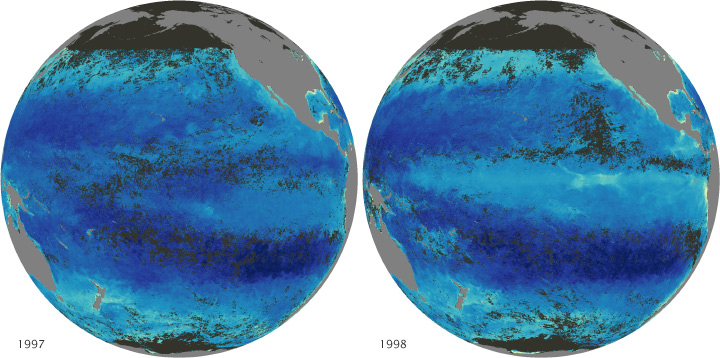
![]()
During an El Niño (Dec 1997, left), upwelling in the equatorial Pacific slows, reducing phytoplankton density. In contrast, a La Niña increases upwelling in the same area, enhancing phytoplankton growth (Dec 1998, right). (NASA image by Jesse Allen & Robert Simmon, based on SeaWiFS data from the GSFC Ocean Colour team.)
El Niño events influence weather patterns beyond the Pacific; in the eastern Indian Sea effectually Indonesia, for example, phytoplankton productivity increases during El Niño. Productivity in the Gulf of Mexico and the western sub-tropical Atlantic has increased during El Niño events in the past decade, probably considering increased rainfall and runoff delivered more nutrients than usual.
Compared to the ENSO-related changes in the productivity in the tropical Pacific, year-to-year differences in productivity in mid- and high latitudes are small.
Long-term changes in phytoplankton
Productivity
Because phytoplankton are so crucial to ocean biology and climate, whatsoever change in their productivity could have a significant influence on biodiversity, fisheries and the human being food supply, and the pace of global warming.
Many models of ocean chemistry and biology predict that as the body of water surface warms in response to increasing atmospheric greenhouse gases, phytoplankton productivity will decline. Productivity is expected to drop because equally the surface waters warm, the water cavalcade becomes increasingly stratified; there is less vertical mixing to recycle nutrients from deep waters back to the surface.

About seventy% of the sea is permanently stratified into layers that don't mix well. Between late 1997 and mid-2008, satellites observed that warmer-than-average temperatures (red line) led to beneath-average chlorophyll concentrations (blueish line) in these areas. (Graph adjusted from Behrenfeld et al. 2009 by Robert Simmon.)
Over the past decade, scientists take begun looking for this trend in satellite observations, and early studies suggest in that location has been a small decrease in global phytoplankton productivity. For case, ocean scientists documented an increase in the expanse of subtropical bounding main gyres—the least productive ocean areas—over the past decade. These low-nutrient "marine deserts" appear to be expanding due to rising ocean surface temperatures.
Species composition
Hundreds of thousands of species of phytoplankton alive in World's oceans, each adapted to item water conditions. Changes in water clarity, nutrient content, and salinity modify the species that live in a given place.
Because larger plankton require more nutrients, they have a greater demand for the vertical mixing of the water column that restocks depleted nutrients. Equally the ocean has warmed since the 1950s, it has become increasingly stratified, which cuts off nutrient recycling.
Continued warming due to the build upwardly of carbon dioxide is predicted to reduce the amounts of larger phytoplankton such as diatoms), compared to smaller types, similar blue-green alga. Shifts in the relative abundance of larger versus smaller species of phytoplankton have been observed already in places around the world, merely whether it will change overall productivity remains uncertain.

As carbon dioxide concentrations (bluish line) increase in the next century, oceans volition get more stratified. As upwelling declines, populations of larger phytoplankton such as diatoms are predicted to decline (greenish line). (Graph adapted from Bopp 2005 by Robert Simmon.)
These shifts in species composition may be benign, or they may effect in a cascade of negative consequences throughout the marine food spider web. Authentic global mapping of phytoplankton taxonomic groups is 1 of the primary goals of proposed future NASA missions like the Aerosol, Cloud, Ecology (ACE) mission.
-
References
- Behrenfeld, One thousand. J., Siegel, D. A., O'Malley, R. T., and Maritorena, Southward. (2009). Global ocean phytoplankton. In T.C. Peterson, and M. O. Baringer (Eds.), Country of the Climate in 2008. Bulletin of the American Meteorological Society. 90(viii), S68–S73.
- Behrenfeld, Thousand. J., O' Malley, R. T., Siegel, D. A., McClain, C. R., Sarmiento, J. 50., Feldman, G. C., Milligan, A. J., et al. (2006). Climate-driven trends in contemporary ocean productivity. Nature, 444(7120), 752-755.
- Behrenfeld, M. J. (2010). Abandoning Sverdrup's Critical Depth Hypothesis on phytoplankton blooms. Environmental, 91(four), 977-989.
- Bopp, L. (2005). Response of diatoms distribution to global warming and potential implications: A global model report. Geophysical Enquiry Letters, 32(L19606).
- Carbon Cycle. (2009). UNEP/GRID-Arendal Maps and Graphics Library. Retrieved June 1, 2010.
- Diaz, R. J., & Rosenberg, R. (2008). Spreading Dead Zones and Consequences for Marine Ecosystems. Scientific discipline, 321(5891), 926-929.
- Feldman, G., Clark, D., & Halpern, D. (1984). Satellite color observations of the phytoplankton distribution in the Eastern equatorial pacific during the 1982-1983 El Niño. Scientific discipline, 226(4678), 1069–1071.
- Gaines, S., & Airame, S. (n.d.). Background: Upwelling. NOAA Sea Explorer Website: Sanctuary Quest. Retrieved May xx, 2010.
- Goes, J. I. Goes, J. I., Thoppil, P. K., Gomes, H. D. R., & Fasullo, J. T. (2005). Warming of the Eurasian Landmass Is Making the Arabian Sea More Productive. Science, 308(5721), 545-547.
- Hallegraeff, Chiliad. M. (2010). Body of water Climate change, Phytoplankton Community Responses, And Harmful Algal Blooms: A Formidable Predictive Claiming. Periodical of Phycology, 46(2), 220-235.
- Hendiarti, Due north., Siegel, H., & Ohde, T. (2004). Investigation of unlike coastal processes in Indonesian waters using SeaWiFS data. Deep Sea Enquiry Part Ii: Topical Studies in Oceanography, 51(1-3), 85-97.
- Gregg, Westward. (2003). Ocean primary production and climate: Global decadal changes. Geophysical Research Letters, 30(fifteen).
- McClain, C. R., Signorini, S. R., & Christian, J. R. (2004). Subtropical scroll variability observed by body of water-color satellites. Deep Sea Inquiry Part Ii: Topical Studies in Oceanography, 51(1-3), 281-301.
- Polovina, J. J., Howell, Due east. A., & Abecassis, M. (2008). Body of water's least productive waters are expanding. Geophysical Inquiry Letters, 35(3).
- Richardson, A. J., & Schoeman, D. S. (2004). Climate Impact on Plankton Ecosystems in the Northeast Atlantic. Science, 305(5690), 1609-1612. Susanto, R. D., Moore, T. Southward., & Marra, J. (2006). Ocean color variability in the Indonesian Seas during the SeaWiFS era. Geochemistry Geophysics Geosystems, 7, Q05021.
- Yoder, J. A., & Kennelly, M. A. (2003). Seasonal and ENSO variability in global body of water phytoplankton chlorophyll derived from 4 years of SeaWiFS measurements. Global Biogeochemical Cycles, 17(4), 1112.
Source: https://earthobservatory.nasa.gov/features/Phytoplankton
Posted by: youngwermell.blogspot.com

0 Response to "What Activity Tansfers Chemical Energy From Algae To Marine Animals"
Post a Comment